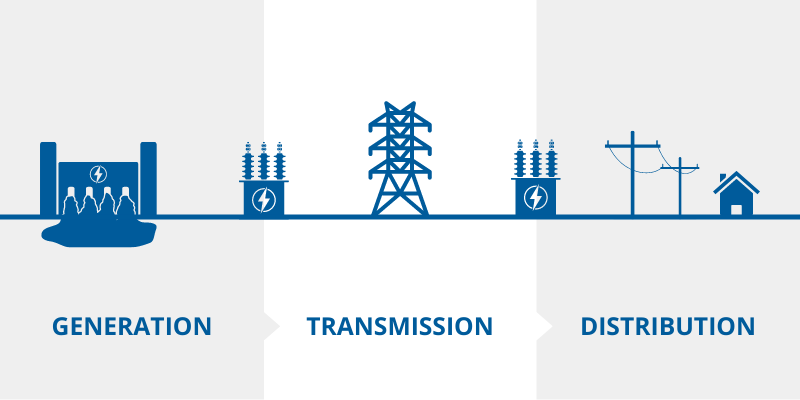In case you’ve ever walked, biked or driven past one of our substations, peered through the chainlink fencing, and wondered, “what secrets do they hold?,” we’re here to fill you in.
To set the stage, remember the pollinator initiative we shared with you last month? Well, that is only a small part of a much larger project we’ve been working on: Power South Nepean, our newest and largest municipal transformer substation on Cambrian Road. As previously mentioned, this new facility will support future growth in Nepean which is expected to double over the next twenty years, and has already doubled since 2002. Since this will be yet another substation to pique your curiosity, we’d like to share with you all the exciting things they do and how they benefit our city.
What is a substation?
A substation is an essential checkpoint for electricity on the power grid while on its way to its destination (you!). As demand for electricity increases and spreads, additional substations or upgrades to existing substations may be needed to manage the supply in a reliable way.
Fun fact: There are currently 92 substations spread across our city, including the Power South Nepean substation (Cambrian Substation) on Cambrian Road West, which is scheduled for completion in spring of 2022.
While there are several different types of substations out there (enough for a whole other article), for simplicity of this blog, we will be describing the general functions that all substations share in order to provide power to our city safely.
What is a substation’s role within the journey of electricity?
At a high level, electricity has three main stages of evolution before it gets to your home or business: generation, transmission, and distribution. As electricity shifts from one stage to the next, substations serve as important links to control, connect and protect the power grid.
At the generation stage, electricity is produced at a relatively low voltage. But, since that electricity has a long distance to travel before arriving at its final destination, it must first go through a substation containing transformers to step-up the voltage (up to 500,000 volts). Voltage is increased for efficiency and to help reduce line losses that happen when electricity must travel long distances (think of it as increasing the pressure on a garden hose). It’s at this point that electricity reaches the transmission stage, where high-voltage power travels along transmission towers.
These towers are designed to be tall and robust for safety reasons, keeping very dangerous electricity levels well above trees and human or animal interaction. The high-voltage power levels become impractical once electricity draws closer to the neighbourhoods in which it will be consumed. It’s at this point where electricity will pass through transformers in yet another substation in order to have its voltage decreased and ready to be distributed (typically less than 10,000 volts). This is one of the roles of the new municipal transformer station that’s being constructed on Cambrian Road, in which the transformers will serve to reduce the voltage of electricity that will be supplied from the provincial grid.
How do substations help prevent prolonged outages?
Since most electrical infrastructure is exposed to the elements of nature (ie. high winds, lightning, tree contact, animal interference), substations must be designed to enable safe switching and circuit disconnections. The important thing to understand is that electricity is determined to keep flowing, so when there is an interruption in its path, it will look for an alternative route. This behaviour leads to short circuits (known as faults) which can then result in outages and serious damage to equipment. To mitigate damage and prolonged outages, protective devices within a substation include switchgear, fuses, and circuit breakers. These devices are designed to allow grid operators to isolate specific distribution circuits, identify problem areas and apply repairs quickly and safely.
Why might Hydro Ottawa build a new substation or expand/upgrade an existing one?
As the city grows outward and upward, our distribution engineers are always thinking ahead to balance safety, reliability, efficiency, and innovation. This involves considerations for upgrades to existing substations and sometimes even the creation of a brand new one.
Brand new stations are constructed when city sprawl significantly increases load requirements – as is the case with the Power South Nepean project. Due to the complexity of building a new station, it can take months or even years to complete, so predictive planning is critical to meeting the growing needs of the city.
Upgrades can consist of installing additional transformers in order to supply additional power to surrounding areas. New transformers provide redundancy by splitting loads under normal operating conditions. An example of an upgrade project that will be taking place this year is the Limebank Station upgrade where a fourth transformer will be added. (Fun fact: transformers can weigh up to 70,000 pounds and require a crane for installation.) Before upgrades are performed, careful considerations are made to ensure that the benefits will far outweigh any possible disruptions to the grid.
A complex and mysterious machine to the untrained eye, substations play a significant role in the journey of electricity, enabling safe, efficient, and reliable delivery of power to our homes and businesses. Now that you know more about the journey of electricity and the role of substations, we hope it will add some colour to your experience the next time you pass by one of our substations.

